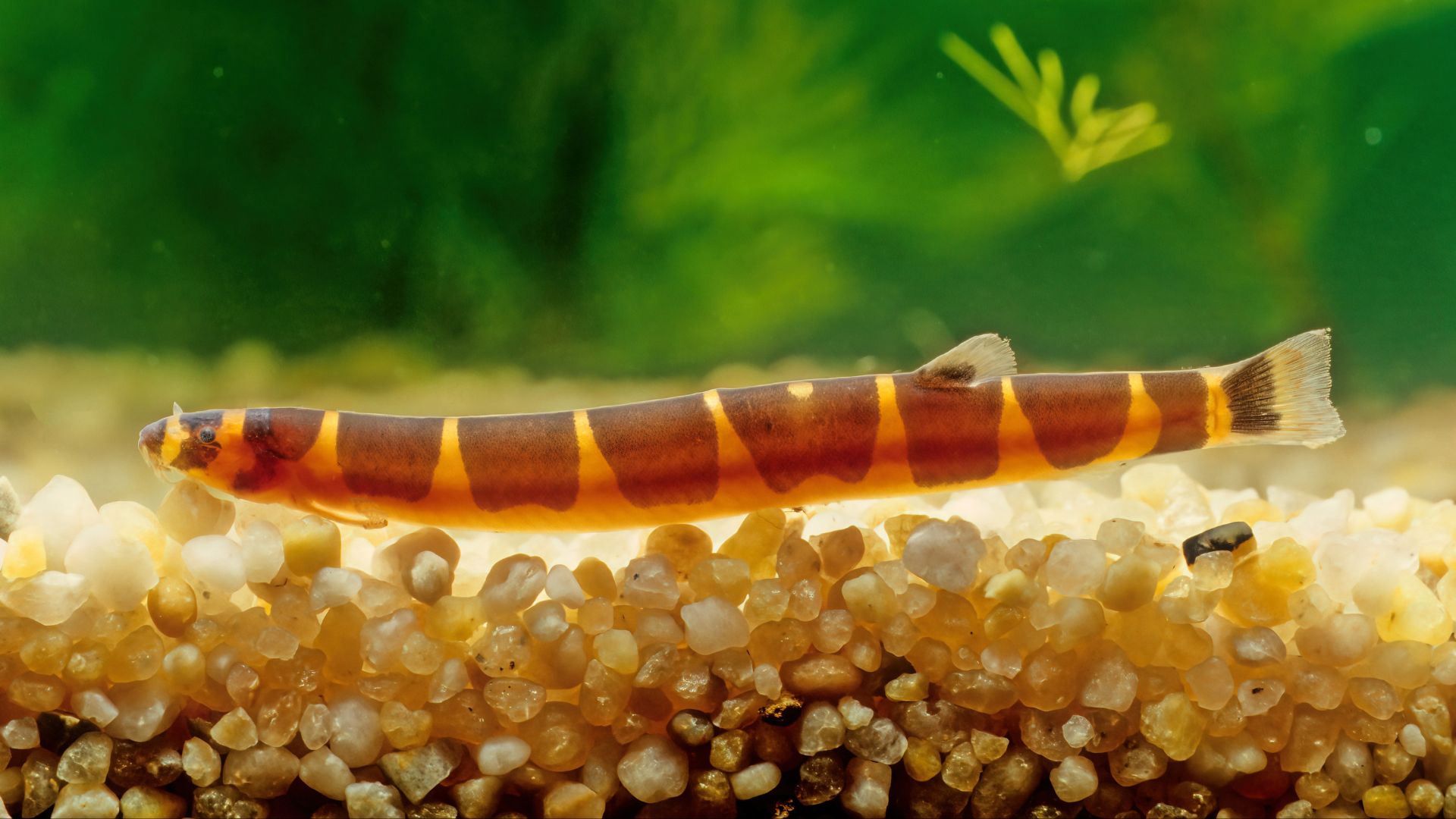
Kuhli Loach
Scientific name: Pangio kuhlii
The Kuhli Loach is a small, eel-like freshwater fish native to the slow-moving streams and rivers of Southeast Asia, particularly Indonesia and Malaysia.
Recognized by its elongated body adorned with vertical bands of dark brown to black and lighter yellow or pinkish stripes, the Kuhli Loach is a fascinating addition to any aquarium. Its secretive and peaceful nature makes it an excellent choice for community tanks, especially for aquarists looking to add diversity to the bottom levels of their aquariums.
IUCN Red List of Threatened Species : Not Evaluated
Kuhli Loaches are nocturnal and tend to be more active during the evening and night. They prefer to be kept in groups of at least three to five individuals, which encourages natural behavior and reduces stress. A well-planted tank with plenty of hiding spots, such as caves, driftwood, and rocks, provides an ideal environment for them. Soft substrate like sand is recommended to protect their sensitive barbels and undersides.
They are omnivorous scavengers that feed on leftover food and detritus, but their diet should be supplemented with sinking pellets, wafers, and occasional live or frozen foods like bloodworms and brine shrimp to ensure proper nutrition.

Navite Location
Southeast Asia (Indonesia, Malaysia, Thailand, and surrounding regions)
Varieties
Common / Half-banded / Myer’s / Black
Suggested Tank Mates
Tetras (Neon, Cardinal) / Rasboras / Danios / Corydoras Catfish / Gouramis (Dwarf Gourami) / Other peaceful community fish
Tank Mates to Avoid
Large or aggressive fish / Cichlids (Oscar, Jack Dempsey) / Large Catfish / Any fish large enough to eat them
Diet
Sinking pellets and wafers / Live or frozen foods (bloodworms, brine shrimp, daphnia) / Algae wafers / Vegetable matter (blanched zucchini or cucumber slices)
Breeding
Breeding Kuhli Loaches in captivity is challenging but not impossible. They require very specific water conditions, including soft, slightly acidic water, and a well-planted tank with fine-leaved plants.
Lifespan
Up to 10 years with proper care
Size
Up to 10 cm (4 inches) in length
Minimum Tank Size
20 gallons (76 liters) for a small group
Optimum Tank Temperature
24°C to 30°C (75°F to 86°F)
Ideal pH Level
5.5 to 6.5
Water Hardness
0 – 5 dGH (soft water)
Common Health Issues
Ich (White Spot Disease) / Skin Flukes / Bacterial Infections / Stress due to poor water quality or inadequate hiding places / Sensitive to medications; treatments should be used carefully
Interesting facts
Burrowing Behavior
Kuhli Loaches often burrow into the substrate, which can help aerate the tank bed but may uproot delicate plants.
Nocturnal Nature
Being nocturnal, they are most active at night. Providing dim lighting can encourage daytime activity.
Group Dynamics
They are social fish that exhibit more natural and active behavior when kept in groups.
Sensitive Barbels
Their barbels (whisker-like organs) are sensitive and help them locate food in the substrate.
Escape Artists
Kuhli Loaches are known to escape through small openings, so a tight-fitting lid is essential.
Kuhli Loach FAQ’s
Are Kuhli Loaches Suitable for Beginners?
Yes, Kuhli Loaches can be suitable for beginner aquarists who are willing to meet their specific care requirements. They are hardy fish but require clean, well-oxygenated water and a tank setup that includes soft substrate and plenty of hiding places. Regular tank maintenance and monitoring of water parameters are important for their health.
Can Kuhli Loaches Be Kept Alone?
While a single Kuhli Loach can survive alone, they are social creatures that thrive when kept in groups of at least three to five.
Keeping them in groups reduces stress and encourages natural behaviors, making them more active and visible in the aquarium.
Do Kuhli Loaches Eat Snails?
Kuhli Loaches are not known to actively hunt and eat snails. They may consume snail eggs or very small snails if they come across them while scavenging, but they are not effective for snail control in an aquarium.
What Do Kuhli Loaches Eat?
Kuhli Loaches are omnivorous scavengers. They feed on leftover food, detritus, and small organisms in the substrate. Their diet should be supplemented with sinking pellets or wafers, as well as live or frozen foods like bloodworms and brine shrimp to ensure they receive adequate nutrition.
Are Kuhli Loaches Nocturnal?
Yes, Kuhli Loaches are primarily nocturnal and are most active during the evening and night. They tend to hide during the day, especially if the aquarium lighting is bright. Providing dim lighting or plenty of hiding spots can encourage them to be more active during daylight hours.
Do Kuhli Loaches Require a Sand Substrate?
A sand substrate is recommended for Kuhli Loaches because they like to burrow and sift through the substrate in search of food. Sand is gentle on their sensitive barbels and undersides. If sand is not possible, use smooth, fine gravel to prevent injury.
Do Kuhli Loaches Get Along with Shrimp?
Kuhli Loaches and shrimp can sometimes coexist peacefully, especially with larger species like Amano shrimp. However, they may prey on very small shrimp or shrimp fry.
If you plan to keep them together, provide plenty of hiding spaces for the shrimp.
Are Kuhli Loaches Sensitive to Medications?
Kuhli Loaches are sensitive to certain medications, especially those containing copper or formalin.
If treatment is necessary, it’s important to use medications at half the recommended dose or choose treatments specifically labeled as safe for scaleless fish.
